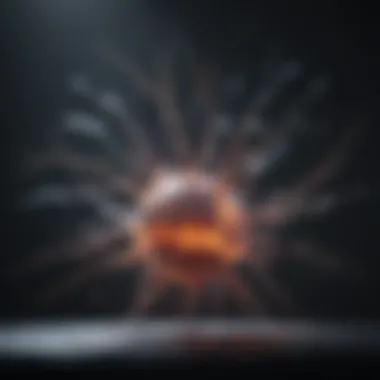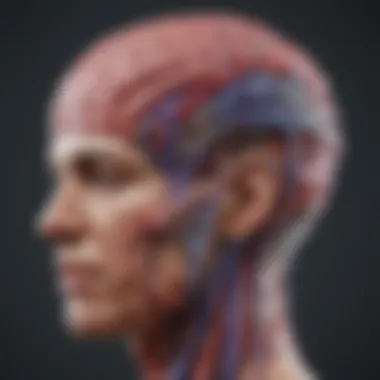Seizures and Brain Injury: Understanding the Complex Interplay


Intro
Understanding the relationship between seizures and brain injury is essential for both medical professionals and researchers alike. Seizures can often be a direct consequence of changes that occur in the brain due to injury, making it crucial to explore how these phenomena interconnect. The dynamics involved are complex and require a detailed examination of the underlying mechanisms.
This article aims to elucidate the multifaceted connections between seizures and various types of brain injuries. It will delve into the specific mechanisms, treatment implications, and ongoing research efforts in this domain. By integrating clinical observations with academic studies, we hope to provide a nuanced perspective for our audience, which includes students, educators, and healthcare professionals.
Key Concepts and Terminology
A clear understanding of terminology is vital for grasping the discussions surrounding seizures and brain injury.
Definition of Key Terms
- Seizure: An abnormal electrical discharge in the brain that can cause changes in behavior, movement, sensation, or consciousness.
- Brain Injury: Any form of injury to the brain, classified into two main categories: traumatic and acquired injuries. Traumatic brain injuries (TBIs) result from external forces, while acquired injuries may develop from conditions like strokes and infections.
- Neuroplasticity: The brain's ability to reorganize itself and form new neural connections in response to learning and injury.
Concepts Explored in the Article
The article covers a range of essential concepts, including:
- Types of brain injuries and their neurological effects.
- The neurological pathways connecting brain injury and seizures.
- Current therapeutic approaches and their efficacy.
- Case studies shedding light on alterations in brain function following trauma.
Findings and Discussion
Main Findings
Research indicates several important links between seizures and brain injury. Brain injuries can disrupt normal brain function, leading to alterations in neuronal excitability. The following findings highlight these connections:
- Type of Injury: Different types of brain injuries can lead to varying seizure manifestations. For example, TBIs often lead to post-traumatic epilepsy, a condition characterized by recurrent seizures following the injury.
- Timing: The onset of seizures can occur immediately after the injury or develop gradually over time. Understanding this timeline is crucial for effective treatment strategies.
- Role of Neuroinflammation: Inflammatory processes activated during brain injury contribute significantly to the development of seizures.
Potential Areas for Future Research
Further research is required to better understand the relationship between seizures and brain injury. Key areas include:
- Investigating the long-term effects of mild brain injuries on seizure risk.
- Exploring the protective roles of neuroplasticity post-injury.
- Developing tailored therapeutic strategies based on patient-specific injury profiles.
"A deeper understanding of seizures linked to brain injuries will enhance both clinical practices and research methodologies, ultimately benefiting patient outcomes."
Prelims to Seizures and Brain Injury
The topic of seizures and brain injury is critical in the field of neurology and rehabilitation. Understanding how these two elements interact can lead to better treatment outcomes for patients. Seizures can directly result from brain injuries, and their presence can complicate recovery efforts. This interplay is multifaceted, affecting not only physical health but also cognitive, emotional, and social aspects of a person's life.
Seizures, characterized by abnormal electrical activity in the brain, can manifest in various forms and severities, each impacting an individual differently. Recognizing the triggers and consequences of these seizures is essential for healthcare professionals. A comprehensive approach is key in managing these phenomena effectively.
Also, a deep dive into brain injury is vital. Not all brain injuries are the same; they vary significantly in cause and effects. From traumatic brain injuries resulting from accidents to non-traumatic causes like strokes, each type can influence seizure development in unique ways.
By connecting these two topics, healthcare providers can enhance patient care. They can maximize recovery through tailored treatments that address both seizure management and brain injury rehabilitation. Moreover, this field is ripe for innovative research, as the understanding of these connections continues to evolve.
Seizures can complicate the healing process of brain injury and vice versa, leading to a cyclical challenge for both healthcare professionals and patients.
This article will explore the definition of seizures, the different types of brain injuries, and their relationship. It will examine the implications for treatment and research, offering a comprehensive guide valuable for students, researchers, educators, and professionals.
Types of Seizures and Their Causes
Understanding the different types of seizures is crucial in the context of brain injury. Each type demonstrates distinct characteristics and underlying mechanisms, which are significant for diagnosis and tailored treatment. Knowing the causes of these seizures is essential because it informs how they may be managed in a clinical setting. Furthermore, it aids in anticipating potential complications that could impact recovery. Individuals with brain injuries are at risk for various seizure types, and recognizing these patterns can lead to improved outcomes through proactive treatment approaches.
Generalized Seizures


Generalized seizures affect both hemispheres of the brain simultaneously. They often present without any initial localized abnormality. This type includes subtypes such as tonic-clonic seizures, absence seizures, and myoclonic seizures. Tonic-clonic seizures involve a phase of muscle rigidity (tonic) followed by rhythmic jerking (clonic). Absence seizures may cause brief lapses in awareness, often mistaken for daydreaming. The myoclonic type is characterized by sudden, brief muscle jerks.
The causes of generalized seizures can vary, but they are commonly linked to metabolic imbalances, genetic predispositions, or widespread structural brian changes. For example, brain injuries, such as traumatic brain injury, may lead to these kinds of seizures as a response to disturbances in neuronal circuits. Hormonal changes and fever can also trigger them, especially in children. Thus, understanding the onset of generalized seizures is essential for recognizing the interplay between seizures and brain health.
Focal (Partial) Seizures
Focal seizures, also known as partial seizures, occur when abnormal electrical activity is localized in one area of the brain. This leads to symptoms that can vary widely, depending on the affected region. There are two main types: simple partial seizures and complex partial seizures. Simple seizures do not affect consciousness, while complex seizures can cause altered awareness.
Causes of focal seizures often include brain lesions, such as tumors or scarring from previous injuries. Specific conditions like epilepsy, stroke, or infections can also contribute to their development. For individuals with brain injuries, it is important to assess whether focal seizures are linked to a specific area impacted by the initial injury. This information can shape the treatment approach and rehabilitation process.
Other Seizure Types
In addition to generalized and focal seizures, there are several other seizure types, each with unique characteristics. These include atonic seizures, which cause a sudden loss of muscle tone, leading to falls. There are also hybrid seizures that exhibit features of both generalized and focal seizures.
As with other seizure types, the causes can stem from a variety of sources, including structural brain changes due to injuries, infections, or metabolic disturbances. Understanding these other types of seizures is important because they may not fit neatly into standard categories and can present additional challenges for management and treatment.
Identifying the type of seizure that occurs after a brain injury is critical for effective management and improves the overall care of patients.
Mechanisms of Injury-Induced Seizures
The mechanisms by which brain injury can lead to seizures are multifaceted and critical to understanding the overall relationship between these two conditions. Seizures can manifest after various types of brain injuries, including traumatic brain injury, stroke, and hypoxic-ischemic events. Comprehending these mechanisms is vital as it informs not only diagnosis but also treatment and rehabilitation.
Pathophysiology of Brain Injury
Injuries to the brain disrupt normal cellular functions and communication. When brain cells are damaged, a cascade of physiological changes occurs, leading to alterations in ion balance, cellular metabolism, and neurotransmitter release.
Disruption in the blood-brain barrier can occur, allowing inflammatory cells and mediators to enter neural tissue, exacerbating damage. This creates an environment conducive to excitability.
The type of injury, its severity, and the location within the brain all play crucial roles in determining the extent and type of seizures that may occur. Acute injuries can result in immediate seizure activity, while chronic changes can lead to potential seizure disorders.
Neuroinflammation's Role
Inflammation is a key player in the processes following brain injury. When the brain is injured, resident immune cells and circulating inflammatory cells are activated. This neuroinflammatory response can lead to the release of cytokines and chemokines that impact neuronal function. Such molecules can induce a state of hyperexcitability where normal neuronal signaling is disrupted.
Neuroinflammation contributes to neuronal death and alters synaptic activity, fostering conditions under which seizures can arise. Studies suggest that targeting neuroinflammatory pathways may offer therapeutic opportunities to mitigate seizure risk after brain injury.
Changes in Brain Excitability
Following injury, the brain undergoes changes in its excitability. Following an injury, the injured area may have increased excitatory activity and decreased inhibition, leading to an imbalance. This can be seen through alterations in the expression of ion channels and receptors, which can enhance excitatory post-synaptic potentials.
Chronic changes in electrical activity can result in seizure susceptibility, leading to spontaneous seizures even in patients where no immediate cause is observable. Over time, regions of the brain can become pathologically altered, creating a vicious cycle of injury and excitability that can complicate recovery.
Understanding these mechanisms is crucial as they provide insight into potential intervention points and therapeutic strategies. This in-depth comprehension aids healthcare professionals in developing more effective treatment modalities for patients experiencing seizures post-brain injury.
Clinical Implications of Seizures Following Brain Injury
The coexistence of seizures and brain injury presents critical clinical implications that extend beyond immediate medical concerns. These implications influence not only the ongoing treatment and recovery strategies for the patient but also shape the long-term management of the condition. Understanding these ramifications is essential for healthcare providers, patients, and families navigating the complexities of brain injuries and their aftereffects.
Diagnosis of Post-Injury Seizures
Accurate diagnosis of seizures that occur post-brain injury is fundamental for appropriate management. Without proper evaluation, seizures may go unnoticed or be misattributed to other potential causes. Clinicians typically rely on a combination of patient history, neurological examinations, electroencephalography (EEG), and neuroimaging studies for accurate diagnosis. Identifying the type of seizure is also important, as different types may indicate varying underlying issues.
A comprehensive evaluation may include:
- Detailed medical history
- Witness accounts of seizure activity
- Neurological assessments
- EEG recordings that can capture abnormal brain wave patterns
- MRI or CT scans to visualize structural changes in the brain


Prompt diagnosis can significantly alter treatment pathways, affecting outcomes and improving quality of life for the affected individuals.
Impact on Recovery and Rehabilitation
Seizures that follow brain injury complicate recovery and rehabilitation processes. The presence of seizures can stall or even undermine progress in physical, occupational, or cognitive therapies. Patients may experience increased fatigue, anxiety, or changes in cognitive function, all of which impede rehabilitation efforts.
Further, the occurrence of seizures can lead to:
- Increased length of hospital stays
- A potential need for more intensive rehabilitation efforts
- Adjustments in medication that may impact overall recovery
Holistic approaches that integrate seizure management into rehabilitation protocols show promise. This includes tailoring physical and cognitive therapies to consider the patient's seizure activity. Communication among healthcare providers, therapists, and the patient is fundamental for a cohesive recovery strategy.
Long-Term Prognosis
The long-term prognosis for individuals suffering from seizures following a brain injury can be varied. Factors influencing prognosis include the type and severity of the initial brain injury, the timing of seizure onset, and the overall response to treatment. Some individuals may achieve significant improvement, while others may endure ongoing challenges.
Statistical outcomes suggest:
- Approximately 10-30% of individuals with traumatic brain injury may experience post-traumatic seizures
- Of these, only some may develop chronic epilepsy, while others see seizures resolve over time
Understanding the long-term implications of these statistics can be pivotal for patients and healthcare providers. Continuous monitoring and adaptive treatment plans can offer better integration of long-term care strategies for managing both seizure activity and potential cognitive deficits.
Understanding the clinical implications of seizures following a brain injury is crucial for facilitating effective treatment plans that enhance long-term quality of life and recovery outcomes.
Treatment Modalities for Seizures Post-Brain Injury
The treatment of seizures following brain injury is crucial in managing patient outcomes and enhancing quality of life. This section examines different strategies to alleviate seizures, providing insight into their significance and the considerations healthcare professionals must navigate. The appropriate approach can mitigate complications and promote recovery, thereby reducing the overall burden on patients and their families.
Pharmacological Interventions
Pharmacological interventions are often the first line of defense against seizures resulting from brain injury. Antiepileptic drugs (AEDs) like levetiracetam, lamotrigine, and phenytoin are frequently prescribed based on the type of seizures and patient-specific factors. The choice of medication can depend on numerous elements including age, medical history, and potential side effects.
Managing dosage effectively is critical. Patients might respond differently, requiring tailored titration to balance efficacy with side effects. Regular follow-up is essential to assess effectiveness and adjust medications as necessary.
Some concerns with pharmacological therapies include:
- Side Effects: Drowsiness, dizziness, and cognitive impacts are common.
- Drug Interactions: Many patients take multiple medications, increasing the risk of adverse interactions.
- Compliance: Patients need to remain consistent with their regimen for optimal results.
Surgical Options
For patients who do not respond adequately to pharmacological treatment, surgical options may become necessary. Surgical intervention can be a definitive approach, particularly in cases of focal seizures that originate from well-defined areas of the brain. The primary goal is to remove the seizure focus, which might significantly improve the patient's overall condition.
Types of surgeries include:
- Resective Surgery: This involves the removal of brain tissue that is the source of seizures.
- Vagus Nerve Stimulation: This is a less invasive option that involves implanting a device to stimulate the vagus nerve and reduce seizure frequency.
- Responsive Neurostimulation: An implanted device can monitor brain activity and deliver targeted electrical pulses when seizure activity is detected.
It is essential that candidates for surgery undergo thorough evaluation by a multidisciplinary team to determine if they will benefit from these invasive procedures.
Rehabilitative Strategies
Rehabilitative strategies play a significant role in the management of seizures after brain injury. They focus on restoring function and improving quality of life through tailored programs that address both physical and cognitive impairments resulting from seizures and the underlying brain injury.
Some rehabilitative approaches include:
- Occupational Therapy: Assists with daily living skills and promotes independence.
- Physical Therapy: Enhances mobility and builds strength, essential for overall recovery.
- Cognitive Behavioral Therapy: Helps patients manage the emotional and psychological impact of living with seizures.


An individualized rehabilitation plan can significantly contribute to the patient’s recovery and long-term well-being. The collaboration between healthcare providers, patients, and families is vital to support successful rehabilitation outcomes.
Understanding and addressing the psychosocial impact of seizures is crucial to comprehensive patient care.
In summary, treating seizures post-brain injury requires a multifaceted approach encompassing pharmacological interventions, surgical options, and rehabilitative strategies. Transparency about risks, benefits, and patient involvement in treatment decisions remains a cornerstone of effective management.
Research Frontiers in Seizures and Brain Injury
Understanding the research frontiers in seizures and brain injury is crucial for several reasons. As scientists delve deeper into the relationship between these two phenomena, they uncover potential pathways for improved diagnosis and treatment. This ongoing research not only helps in better management of affected patients but also contributes to the broader field of neurology and rehabilitation medicine. Advances in this area can address both the biological mechanisms of injury-induced seizures and the psychological impacts that come after such events.
Emerging Trends in Research
Currently, there are several emerging trends within the research community focused on seizures and brain injury. One trend involves the exploration of neuroimaging techniques that allow for a non-invasive look at brain activity. MRI and PET scans can provide insights into seizure foci and help understand how brain injuries affect neural networks. Additionally, studies are increasingly focusing on the role of genetics in susceptibility to seizures after brain injury. Understanding genetic factors can help tailor more personalized treatment plans, enhancing patient outcomes.
Potential Biomarkers for Prediction
The identification of biomarkers for predicting seizures is an exciting frontier in this research domain. Biomarkers can serve as early indicators of which individuals are at risk for developing post-injury seizures. For instance, studies are investigating specific proteins or metabolites in cerebrospinal fluid that correlate with seizure activity. Identifying these biomarkers can significantly streamline diagnosis and allow for early interventions. Furthermore, the development of predictive models based on these biomarkers could change the approach to clinical practice for patients after brain injury.
Innovative Treatment Approaches
Innovative treatment approaches are being developed to address seizures associated with brain injuries. One such method includes the use of neuromodulation techniques, like transcranial magnetic stimulation (TMS). TMS has shown promise in influencing neuronal excitability, which may help prevent seizures in susceptible individuals. Another promising area is the implementation of newly formulated antiepileptic drugs that target specific neural pathways altered by brain injury. Research is also exploring the efficacy of combined therapies—using pharmacological treatments alongside cognitive rehabilitation to improve overall function and quality of life for affected patients.
"The integration of cutting-edge research into clinical practice has the potential to significantly improve outcomes for individuals suffering from seizures following brain injury."
In summary, the exploration of emerging trends, identification of biomarkers, and innovative treatment methods mark an intellectually rich landscape in the study of seizures and brain injury. This is an ever-evolving field, and ongoing research is essential for advancing both understanding and patient care.
Psychosocial Aspects of Living with Seizures and Brain Injury
The psychosocial aspects involved in living with seizures and brain injury are significant and multifaceted. Patients face not only the medical implications of their condition but also emotional and social challenges that can impact their quality of life. Understanding these aspects is essential in fully addressing the needs of individuals affected by these conditions.
Mental Health Considerations
Mental health is often a critical yet overlooked component of recovery from brain injury and the occurrence of seizures. Individuals might experience a range of psychological disorders, including depression and anxiety. It is vital to recognize that brain injuries often disrupt normal brain function, which can lead to changes in mood and behavior. Factors like the stigma surrounding seizures can amplify feelings of isolation or shame. Moreover, many individuals may struggle to adapt to their new reality, leading to a sense of loss or grief over their previous capabilities. Therefore, regular psychological evaluations and therapeutic interventions are crucial.
Social Integration Challenges
Social integration can become increasingly complex for individuals living with seizures and brain injuries. Patients may find it challenging to participate in various social activities due to fear of having a seizure in public or the stigma associated with it. They might withdraw from engaging with friends and family, which can affect their social networks. Additionally, societal misconceptions about their condition often result in misunderstandings that can further isolate them. Encouraging open communication and education about the nature of seizures and the effects of brain injuries can help. Community support groups can also play a role in facilitating social connections while ensuring a safe environment for sharing experiences.
Support Mechanisms for Patients and Families
Effective support mechanisms are crucial for both patients and their families. Support can come in various forms, including specialized healthcare services, educational resources, and emotional backing from loved ones. Families often experience significant stress as they adapt to the changes that brain injury and seizures bring. They require clear information about the conditions and ways to provide proper care. Patient support groups can also foster understanding and provide a platform for expressing shared experiences.
"Support networks can significantly reduce the feeling of isolation experienced by individuals with seizures. These connections can provide much-needed emotional relief and practical assistance."
In summary, addressing the psychosocial aspects of living with seizures and brain injury is essential for holistic recovery. Mental health considerations, social integration challenges, and support mechanisms all play integral roles in improving the well-being of affected individuals. A comprehensive approach that includes education, psychological support, and community resources is necessary for enhancing their quality of life.
Endings and Future Perspectives
Understanding the relationship between seizures and brain injury is crucial not only for the medical community but also for patients and their families. The interplay manifests in various ways, affecting recovery and quality of life.
Summarizing Key Findings
Throughout this article, we explored several essential aspects:
- Seizure Types and Their Causes: We discussed generalized, focal, and other types of seizures, detailing the underlying causes associated with each type.
- Mechanisms Behind Injury-Induced Seizures: The pathophysiology, neuroinflammation, and changed brain excitability were highlighted as significant factors linking brain injury to seizure activity.
- Clinical Implications: Diagnosis, management, and the impact of seizures on recovery were discussed in depth, emphasizing the need for continual monitoring and adjustment of treatment plans.
- Treatment Modalities: We examined pharmacological methods, surgical options, and rehabilitative strategies, demonstrating the multifaceted approach needed to address these challenges.
- Psychosocial Aspects: We recognized the mental health considerations for individuals facing these conditions, along with the social integration problems they might encounter.
Future Research Directions
There are several avenues for future research that could enhance our understanding and management of seizures following brain injury:
- Identification of Biomarkers: Researchers should focus on identifying reliable biomarkers that can predict the onset of seizures in patients with brain injuries, potentially allowing for preemptive treatment measures.
- Innovative Therapeutic Approaches: Exploring novel intervention methods, such as gene therapy or neurostimulation, could lead to more effective management strategies.
- Longitudinal Studies: Conducting long-term studies will help to analyze the outcomes of different interventions and understand how seizures evolve over time in individuals with varying types of brain injuries.
- Patient-Centric Research: Emphasizing patient experiences and outcomes can guide future therapeutic developments and help tailor strategies to meet their unique needs.







